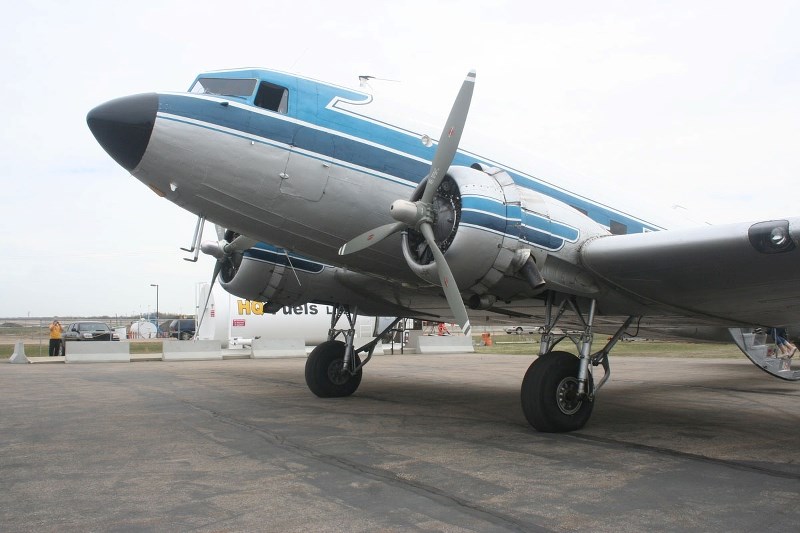It’s not exactly what you would call a smooth ride. Mind you, coming from a guy who is known to get woozy on a Ferris wheel, that’s not saying much.
But one doesn’t board a vintage DC-3 with the intention of having a relaxing little jaunt around the area. For me, anyway, it was a remarkable opportunity to experience first-hand such an important piece of history.
The Alberta Aviation Museum Association and Kingdom Air Corps, a missionary group based out of Alaska, arranged for the stop in which will use the plane for humanitarian work in Alaska and in far eastern Russia.
A Second World War era DC-3, or C-47 as it was known during the war, made a stop at the Villeneuve Airport last Tuesday en route to Alaska, recreating the journey from Great Falls, Mont., up to Anchorage, Alaska, via Edmonton and the Yukon.
To help commemorate the 70th anniversary of the Victory in Europe on May 8, Kingdom Air pilot and owner Dwayne King said he was humbled to be able to recreate the route, and noted he’s heading across the Bering Strait at the behest of Russian officials also eager to commemorate the occasion.
“It’s the thing that draws our countries together,” he said. “This is why we are trying to make this happen, because it really encourages and fosters peace and harmony between our countries.”
There were thousands of airplanes that followed that route in the early 1940s, most of which were headed to the Soviet Union as part of the Lend-Lease program, which saw American equipment provided to the Soviets and other Allies to help fight the Axis powers. Approximately 700 of those were DC-3s.
Rod Macleod, a professor emeritus of history and past-president of the museum association, said you cannot really understate the significance of this route, and the “workhorse” DC-3 itself, in helping to win the war.
“It was hugely important. Eight thousand military aircraft went through to the Russians,” he said. “It was one of the big game-changing things during the Second World War because there weren’t any other really good ways to get airplanes to the Soviet Union.”
The other options would have involved sending the planes by boat, a dicey proposition while naval battles raged in the Atlantic and the Pacific.
It is not a particularly comfortable ride, and the noise of the engines starting up made discussion during the flight a bit difficult.
The seats and other equipment in King’s DC-3 appeared to be original, and a small metal fan next to a backlit “No Smoking” sign reinforced the fact this airplane has been around for quite some time.
The museum’s communications co-ordinator Steve Finkelman was visibly excited about the opportunity to fly in the plane, and was eager to explain the little details that make it unique: a tail dragger instead of a nose wheel, giving the plane a slant while it’s landed, the fact the tail flaps include fabric and not just metal parts, and even the smell reminiscent of an old school bus that’s an indication of the amount of oil the engine burns.
“I have never flown in a DC3 before,” he said. “It’s loud, it’s noisy, I love the smell of the oil. It burns gallons of oil. It’s just so different.”
Macleod said while he has had the opportunity to fly in DC-3 before, he was nonetheless impressed with the opportunity to do it again.
“It’s extremely cool,” he said. “There’s nothing like being in the real thing.”




